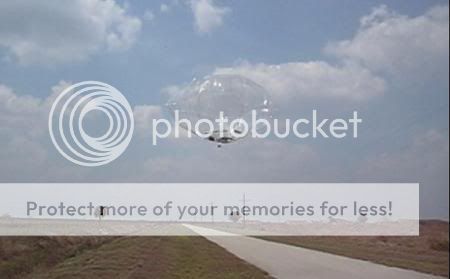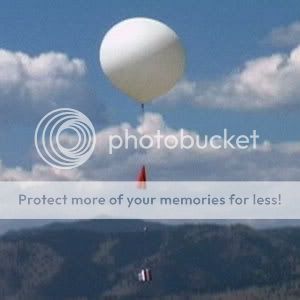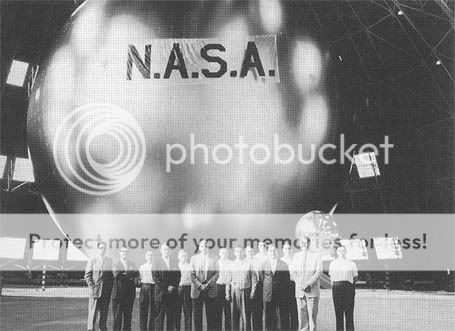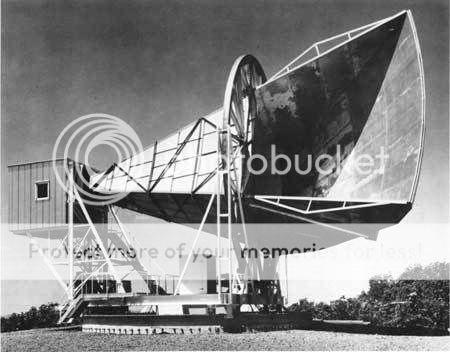It looks like you're using an Ad Blocker.
Please white-list or disable AboveTopSecret.com in your ad-blocking tool.
Thank you.
Some features of ATS will be disabled while you continue to use an ad-blocker.
0
share:

I came across this picture while I was browsing google, and it made me wonder if this is what some people mistook for ufos, or perhaps this is the type of weather balloon they used as a cover for the area 51 crash?
Thoughts?
Oh, by the way, it's nasa's birthday
Edit: www.flickr.com...
This is the link/explanation of the pic. It's real! Quite large, too. Those people look like ants compared to it.
It's called a Satelloon, btw
[edit on 30-7-2008 by Kaytag]
[edit on 30-7-2008 by Kaytag]
[edit on 30-7-2008 by Kaytag]
reply to post by Kaytag
Hi there Kaytag!welcome to ATS!!!
Happy B-day NASA, now could you guys please stop editing mars and moon images....
Well that image looks a bit fake.....Where dit you get the image!
I would say yes lets use your image for example imagine during the day sunny day silver metallic look high in the sky!The compressed air in high altitude will shapeshift the balloon too...so yes alot of people are mistaken that it is a UFO..

NASA's "Smart" Weather Balloons Self-Destruct – To Stop Being Mistaken for UFOs? - When they get too far from the launch site, they deflate
You can read more here about weather balloons

[edit on 7/30/2008 by GUNSINWAR]
Hi there Kaytag!welcome to ATS!!!
Happy B-day NASA, now could you guys please stop editing mars and moon images....
Well that image looks a bit fake.....Where dit you get the image!
I would say yes lets use your image for example imagine during the day sunny day silver metallic look high in the sky!The compressed air in high altitude will shapeshift the balloon too...so yes alot of people are mistaken that it is a UFO..

NASA's "Smart" Weather Balloons Self-Destruct – To Stop Being Mistaken for UFOs? - When they get too far from the launch site, they deflate
news.softpedia.com...
Enlarge pictureWeather balloons are usually helium- or hydrogen-filled balloons which carry instruments on board to send back information on atmospheric pressure, temperature, humidity and wind. They can reach altitudes of 40 km (25 miles) or more and on some occasions, have been sometimes cited as the cause for UFO sightings.
Now, NASA is developing a new type of "smart" balloons that can do the same job of monitoring weather conditions, only they do it around the rocket pads on launch days and now they can self-destruct when they get too far from the base. The balloons are built using the same technology that developed the smart dust, the miniature sensors capable of analyzing the surrounding environment and sending back data through microtransmitters, while drifting in the wind.
Using solar energy for power, the balloons will be carrying temperature, pressure, humidity and GPS sensors and transmitters that can relay data even if the balloons drift too far away from the launching point.
Unfortunately, these balloons are not 100% reliable, as only three of them were able to transmit data out of the eight initially launched, most likely because of malfunctions to the experimental GPS system.
Enlarge pictureThe self-destruct mechanism is designed to release the helium that insures the flotation and to bring them back to Earth if they get too far, just before a space shuttle is launched.
The price of these complex balloons is not high at all, considering the equipment they're carrying, each of them costing $500, with up to seven of them being launched before the spacecraft launches. But for NASA officials, "collecting the data in this way is much more cost-effective than using aircraft or conventional balloons."
In theory, these balloons could be reused for multiple launches, but in practice, they are blown so far that most are lost.
You can read more here about weather balloons

[edit on 7/30/2008 by GUNSINWAR]
reply to post by Kaytag
Thanks for the Flickr Link!

Jip you are indeed right! Sateloons
In his 1995 history of NASA Langley, Space Revolution, Dr. James Hansen wrote:
 The original research proposal put forward by a Langley engineer
named William J. O'Sullivan called for a 20-inch balloon, which was increased to 30 inches. These "Sub Satellites" were followed by a 12-foot
diameter Beacon satelloon, the size of which was determined, not by any scientific requirements, but by the ceiling height in the Langley model
fabrication room. greg.org...
The original research proposal put forward by a Langley engineer
named William J. O'Sullivan called for a 20-inch balloon, which was increased to 30 inches. These "Sub Satellites" were followed by a 12-foot
diameter Beacon satelloon, the size of which was determined, not by any scientific requirements, but by the ceiling height in the Langley model
fabrication room. greg.org...

Very interesting stuff indeed....Thanks Kaytag for a interesting thread...Big star for you
Thanks for the Flickr Link!

Jip you are indeed right! Sateloons
en.wikipedia.org...
Following the failure of the Delta rocket carrying Echo 1 on May 13, 1960, Echo 1A (commonly referred to as just Echo 1) was successfully put in a 1519 x 1687 km orbit on August 12, 1960. The 30.5 meter (100 foot) diameter balloon was made of 0.127 mm (0.005 inch) thick metallized Mylar polyester film and was successfully used to redirect transcontinental and intercontinental telephone, radio, and television signals. The satellite also aided the calculation of atmospheric density and solar pressure due to its large area-to-mass ratio. As its shiny surface was also reflective in the range of visible light, Echo 1A was visible to the unaided eye over most of the Earth. Brighter than most stars, it was probably seen by more people than any other man-made object in space. Echo 1A reentered Earth's atmosphere and burned up on May 24, 1968.
Echo 1 was a passive communications satellite: it functioned as a reflector, not a transmitter. After it was placed in a low orbit of the Earth, a signal would be relayed to Echo, reflected or bounced off its surface, then returned to Earth. Echo 1 was visible to the eye because of its shiny surface, but also because of its low orbit; it would appear from below one side of the horizon, cross the sky, then disappear below the opposite horizon after crossing the sky, as happens with all LEO satellites. The spacecraft was nicknamed a 'satelloon' by those involved in the project.
In his 1995 history of NASA Langley, Space Revolution, Dr. James Hansen wrote:
The Echo balloon was perhaps the most beautiful object ever to be put into space. The big and brilliant sphere had a 31,416-square foot surface of Mylar plastic covered smoothly with a mere 4 pounds of vapor-deposited aluminum. All told, counting 30 pounds of inflating chemicals and two 11-ounce, 3/8-inch-thick radio tracking beacons (packed with 70 solar cells and 5 storage batteries), the sphere weighed only 132 pounds.
For those enamored with its aesthetics, folding the beautiful balloon into its small container for packing into the nose cone of a Thor-Delta rocket was somewhat like folding a large Rembrandt canvas into a tiny square and taking it home from an art sale in one's wallet.

greg.org...
To communicate with the Echo satelloons, Bell Labs built a 50-foot long horn-shaped antenna in Holmdel, which could rotate and pivot on several axes. Later, in 1964, while calibrating the antenna, Drs. Arno Penzias and Robert Wilson detected microwave background radiation, the first concrete evidence of the Big Bang theory. They were awarded the Nobel Prize in 1978.
Echo II was launched in 1964. Both Echo satelloons stayed aloft for years [until 1968 and 1969, respectively] Though not very efficient, their passive communications technology spurred on the development of active signal-transmitting communications satellites like Telstar. An Echo II was exhibited at the 1964 New York World's Fair, and a folded backup is on display at the National Air & Space Museum.
Very interesting stuff indeed....Thanks Kaytag for a interesting thread...Big star for you
reply to post by Kaytag
Yes Kaytag,
It was nice to see a sane post in this section of ATS. Thank you very much!
A star from me as well and a very bigh welcome to ATS. Thinking folks always welcome here in my book.
Vance
Yes Kaytag,
It was nice to see a sane post in this section of ATS. Thank you very much!
A star from me as well and a very bigh welcome to ATS. Thinking folks always welcome here in my book.
Vance
new topics
-
Turkey Calls for an Islamic Alliance to Counter Israeli Expansionist Threat
Middle East Issues: 15 minutes ago -
BIden Took 48 Years Worth of Vacation While President
US Political Madness: 2 hours ago -
Elderly British Couple Use Double Suicide Pod in Switzerland
Social Issues and Civil Unrest: 2 hours ago -
Donald TRUMP on the Fate of Election Fraudsters if Americans Elect Him President Again.
2024 Elections: 8 hours ago
top topics
-
Donald TRUMP on the Fate of Election Fraudsters if Americans Elect Him President Again.
2024 Elections: 8 hours ago, 13 flags -
Nano bots in the vaccine
Science & Technology: 12 hours ago, 12 flags -
Political Realignment: 88 Big-Business Leaders Endorse Kamala Harris
2024 Elections: 16 hours ago, 11 flags -
Numerous’ people shot in ‘active shooter’ situation on highway near small town in Kentucky
Breaking Alternative News: 12 hours ago, 11 flags -
BIden Took 48 Years Worth of Vacation While President
US Political Madness: 2 hours ago, 4 flags -
Russia is now saying what the 'Conspiracy Theorist' have been saying for awhile now
Mainstream News: 12 hours ago, 3 flags -
Judges
Religion, Faith, And Theology: 14 hours ago, 2 flags -
Elderly British Couple Use Double Suicide Pod in Switzerland
Social Issues and Civil Unrest: 2 hours ago, 2 flags -
Turkey Calls for an Islamic Alliance to Counter Israeli Expansionist Threat
Middle East Issues: 15 minutes ago, 1 flags
0
